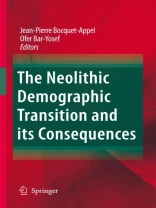The transition from hunting and gathering to farming – the Neolithic Revolution – was one of the most signi cant cultural processes in human history that forever changed the face of humanity. Natu an communities (15, 100–12, 000Cal BP) (all dates in this chapter are calibrated before present) planted the seeds of change, and the Pre-Pottery Neolithic (PPN) (ca. 12, 000–ca. 8, 350Cal BP) people, were the rst to establish farming communities. The revolution was not fully realized until quite late in the PPN and later in the Pottery Neolithic (PN) period. We would like to ask some questions and comment on a few aspects emphas- ing the linkage between biological and cultural developments during the Neolithic Revolution. The biological issues addressed in this chapter are as follows: × Is there a demographic change from the Natu an to the Neolithic? × Is there a change in the overall health of the Neolithic populations compared to the Natu an? × Is there a change in the diet and how is it expressed? × Is there a change in the physical burden/stress people had to bear with? × Is there a change in intra- and inter-community rates of violent encounters? From the cultural perspective the leading questions will be: × What was the change in the economy and when was it fully realized? × Is there a change in settlement patterns and site nature and organization from Natu an to Neolithic? × Is there a change in human activities and division of labor?
Jadual kandungan
Demographic and Economic Dimensions of the NDT.- The Expansions of Farming Societies and the Role of the Neolithic Demographic Transition.- Explaining the Neolithic Demographic Transition.- The Signal of the Neolithic Demographic Transition in the Levant.- The Nature and Timing of the Neolithic Demographic Transition in the North American Southwest.- The Neolithic Demographic Transition in Mesoamerica? Larger Implications of the Strategy of Relative Chronology.- An Alternative Approach in Tracing Changes in Demographic Composition.- Zooarchaeological Aspects of the Neolithic Diet Transition in the Near East and Europe, and Their Putative Relationships with the Neolithic Demographic Transition.- Impacts of the Neolithic Demographic Transition on Linear Pottery Culture Settlement.- Settlement and Village Practices.- A Roof Over One’s Head: Developments in Near Eastern Residential Architecture Across the Epipalaeolithic–Neolithic Transition.- Demography and Storage Systems During the Southern Levantine Neolithic Demographic Transition.- Population Processes and Their Consequences in Early Neolithic Central Europe.- Community Size and Social Organization.- Global Patterns of Early Village Development.- Centralized Communities, Population, and Social Complexity After Sedentarization.- Charming Lives: Human and Animal Figurines in the Late Epipaleolithic and Early Neolithic Periods in the Greater Levant and~Eastern Anatolia.- Evaluating the Emergence of Early Villages in the North American Southwest in Light of the Proposed Neolithic Demographic Transition.- Population Growth and Health.- Demographic, Biological and Cultural Aspects of the Neolithic Revolution: A View from the Southern Levant.- Implications of the NDT for World Wide Health and Mortality in Prehistory.-From Health to Civilization Stress? In Search for Traces of a Health Transition During the Early Neolithic in Europe.- Prehistoric Demography in a Time of Globalization.- Prehistoric Demography in a Time of Globalization.












